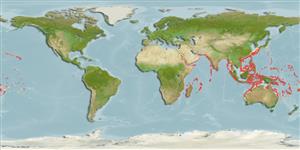Common names from other countries
分類 / Names
俗名 | 同種異名 | Catalog of Fishes(屬, 種) | ITIS | CoL | WoRMS | Cloffa
Teleostei >
Eupercaria/misc (Various families in series Eupercaria)
鱸形目 (Various families in series Eupercaria) >
Lutjanidae (Snappers)
笛鯛科 (Snappers) > Etelinae
Etymology: Aphareus: Greek, aphareys, -eos = water wings under the belly of female tunna (Ref. 45335).
More on author: Cuvier.
Environment: milieu / climate zone / depth range / distribution range
生態學
海洋 礁區魚類; 深度上下限 100 - 330 m (Ref. 37816). 熱帶; 35°N - 35°S, 24°E - 150°W (Ref. 55)
Indo-Pacific: East Africa to the Hawaiian Islands, north to the Ryukyu and Ogasawara islands, south to Australia. Southeast Atlantic: Port Alfred, South Africa (Ref. 11228).
印度-太平洋: 東非到夏威夷群島, 北至琉球與小笠原群島, 南至澳洲。 東南大西洋: 南非的艾佛烈港.(參考文獻 11228)
大小 / 重量 / 年齡
Maturity: Lm ? range ? - ? cm
Max length : 110 cm TL 雄魚/尚未辨別雌雄; (Ref. 5484); common length : 79.0 cm SL 雄魚/尚未辨別雌雄; (Ref. 37816); 最大體重: 11.3 kg (Ref. 4887)
背棘 (總數) : 10; 背的軟條 (總數) : 10 - 11; 臀棘: 3; 臀鰭軟條: 8. This species is distinguished by the following characters: body elongate and laterally compressed; lower jaw protruding; premaxillae not protrusible, fixed by a frenum; teeth in jaws are extremely small, minute in large adults; roof of mouth toothless; maxilla without scales or longitudinal ridges; interorbital region flattened; gill openings extending far anterior to orbit; gill rakers on first gill arch 16 - 19 + 32-35 = 49-52; last soft ray of both dorsal and anal fins well produced, longer than next to last ray; caudal fin forked; D X,11 (occasionally 10); membranes of dorsal and anal fins without scales; tubed lateral-line scales 69-75. Colour of body blue-grey or mauve to overall reddish; margin of maxilla black; in some specimens, at least, inside of mouth, gill chamber, and gills shining silver; fins yellowish to reddish except pelvic and anal fins sometimes whitish (Ref. 9821).
顎骨延伸至眼睛中央下方; 眼間隔平的。 背鰭與臀鰭沒有鱗片。 通常藍灰色的或淡紫色到全體淡紅的; 鰭淡黃色的到淡紅的除腹鰭,而且臀鰭有時那是微白色的; 顎骨黑色的邊緣。
Adults inhabit reefs and rocky bottom areas to depths of at least 100 m (Ref. 4887). Found in pelagic and benthopelagic waters (Ref. 58302). They feed on fishes, squids and crustaceans (Ref. 4887). Marketed fresh (Ref. 37816).
棲息於礁與岩石的底部區域到深度至少 100 公尺。 吃魚,烏賊與甲殼動物。 (參考文獻 4887) 在市場上銷售生鮮地了。
Life cycle and mating behavior
Maturities | 繁殖 | Spawnings | Egg(s) | Fecundities | 仔魚
印度-太平洋: 東非到夏威夷群島, 北至琉球與小笠原群島, 南至澳洲。 東南大西洋: 南非的艾佛烈港.(參考文獻 11228)
Allen, G.R., 1985. FAO Species Catalogue. Vol. 6. Snappers of the world. An annotated and illustrated catalogue of lutjanid species known to date. FAO Fish. Synop. 125(6):208 p. Rome: FAO. (Ref. 55)
CITES (Ref. 128078)
Not Evaluated
人類使用
漁業: 商業性; 游釣魚種: 是的
工具
特別的報告
下載 XML
網路資源
Estimates based on models
Preferred temperature (Ref.
115969): 14.1 - 23.3, mean 18.4 (based on 229 cells).
Phylogenetic diversity index (Ref.
82804): PD
50 = 0.7500 [Uniqueness, from 0.5 = low to 2.0 = high].
Bayesian length-weight: a=0.01549 (0.01242 - 0.01931), b=2.93 (2.87 - 2.99), in cm Total Length, based on LWR estimates for this species (Ref.
93245).
營養階層 (Ref.
69278): 4.1 ±0.57 se; based on food items.
回復力 (Ref.
120179): 中等的, 族群倍增時間最少 1.4 - 4.4年 (K=0.16).
Fishing Vulnerability (Ref.
59153): Moderate to high vulnerability (53 of 100).
Climate Vulnerability (Ref.
125649): High to very high vulnerability (73 of 100).
